Conclusion
This chapter has described the methodology used to conduct
this study. First, there is a presentation of the participants in this work and
the context in which it has been conducted. Then there is a description of the
procedures followed to collect data from either students' questionnaire or
teachers' interview and the ones followed for the data analysis, which consist
of statistical analysis for quantitative data and a descriptive analysis for
qualitative data. The next part will be the presentation of the findings.

Chapter Three
Presentation of the
Findings
28
Chapter III Presentation of the Findings
Introduction
This chapter presents the findings reached during conducting
our investigation using two main tools: students' questionnaire and teachers'
interview. The results are presented in the form of tables, diagrams and pie
charts. We have divided this part into two sections, the first deals with
presenting the results of the students' questionnaire and the second presents
the findings of the teachers' interview. These two have been conducted with
students and teachers of the Department of English at Mouloud Mammeri
University of Tizi Ouzou.
3.1. Presentation of the Results of the Students'
Questionnaire:
3.1.1. General Information about the Participants Q1:
What is your option?
|
Options
|
Participants
|
Percentages
|
|
Language and Communication
|
42
|
32.31%
|
|
Didactics of Foreign Languages
|
22
|
16.92%
|
|
Literature and Civilisation
|
23
|
17.69%
|
|
Literature and Interdisciplinary Approaches
|
19
|
14.62%
|
|
Comparative Literature
|
24
|
18.46%
|
|
130
|
100%
|
Table1. Distribution of Master I Students
This table shows the different options from which we have
selected our participants. The results show that the majority of them (32.31%)
study Language and Communication; (18.46%) study comparative literature.
(17.69%) of the participants study Literature and Civilisation, (16.92%) study
Didactics of Foreign Languages and the remaining (14.62%) study Literature and
Interdisciplinary Approaches.
29
Chapter III Presentation of the Findings
Q2. How long have you been studying English?
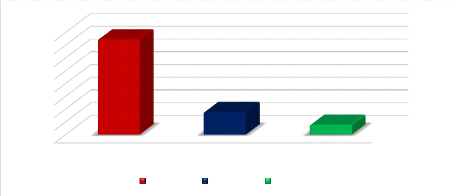
40
80
70
60
50
30
20
10
0
11 years 12 years 13 years
74.62%
11 years 12 years 13 years
17.69% 7.69%
Diagram1. Students' Experience in English
From the Pie chart above, the majority of the students
(76.62%) declared that they have been studying English for 11 years which is
the ordinary number for a master one student. (17.69%) declared that they have
been studying English for 12 years, and (7.69%) stated that they have been
studying English for 13 years; consequently, they may have repeated one or two
levels.
Q3. Have you ever been abroad for a linguistics
seminar?
|
Options
|
Participants
|
Percentages
|
|
Yes, I have
|
110
|
84.62%
|
|
No, I have not
|
20
|
15.38 %
|
|
Total
|
130
|
100%
|
Table2. Students' Experience Abroad
The table above shows that (84.62%) of the students have never
been into other countries for a linguistic seminar; however, (15.38%) of them
have actually some experience abroad and say they have participated in
linguistic seminars.
30
Chapter III Presentation of the Findings
3.1.2. Students' Attitudes towards the Use of
Collaborative Visualisation in English in the Department of
English.
Q1: «Mutual activation (active collaboration
among students) and share of knowledge is foundational for developing students'
communication skills».
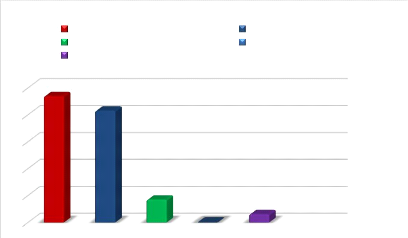
Strongly agree Agree
Slightly agree Disagree
Strongly disagree
46.92%
41.54%
8.46%
0% 3.08%
Diagram2. Students' Opinions about Mutual Activation
in Developing their Communication Skills.
As the diagram shows, a great percentage of Master One
students (46.92%) strongly agree that mutual activation is foundational to
promote students' communication skills. (41.54%) of them agree; whereas (8.46%)
slightly agree. While no one disagrees; only (3.08%) strongly disagree that the
share of knowledge is fundamental in developing students' communication
skills.
31
Chapter III Presentation of the Findings
Q2: «Grounding or creating a common frame of
reference (particular set of beliefs or ideas on which you base your
judgment of things)», to promote students' communication skills,
is:
Very important Important Slightly important Not
important

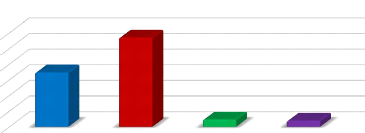
34.62%
56.92%
4.62% 3.85%
Very Important Slightly Not important
important important
Diagram3. The Importance of Grounding or Creating a
Common Frame of Reference to Promote Students' Communication
Skills.
The results presented in this diagram display that the
majority of the respondents (56.92%) believe in the importance of grounding in
developing students' communication skills. (34.62%) said that Grounding is not
only important, but also very important. While (4.62%) believe that it is
slightly important, only (3.85%) think that grounding is not important.
Q3: Do you try to maintain the discussion during a
collaborative activity?
|
Options
|
Participants
|
Percentages
|
|
Yes
|
123
|
95%
|
|
No
|
7
|
5%
|
|
Total
|
130
|
100%
|
Table 3. Students' Discussion Maintenance in
Classroom.
32
Chapter III Presentation of the Findings
The table displays that almost all the participants (94.62%) do
try to maintain the discussion during a collaborative activity; they answered
by `Yes'; whereas, (5.38%) have answered by `No', which means they do not try
to maintain the discussion.
Justification
|
Items
|
participants
|
Percentage of the
participants%
|
a. Asking questions
|
77
|
59.23%
|
b. Suggesting ideas
|
63
|
48.46%
|
c. Giving one's opinion
|
71
|
54.62%
|
d. Repairing focus divergence
|
9
|
6.92%
|
e. Clarifying and summarizing what has been
said
|
22
|
16.92%
|
f. Providing feedback
|
|
18
|
13.85%
|
|
Table4. Students' Techniques for Maintaining
Discussion
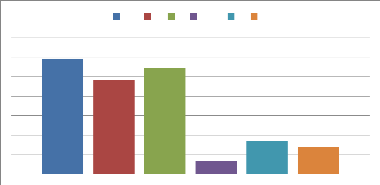
a b c d e f
59.23%
54.62%
48.46%
6.92%
16.92% 13.85%
Diagram4. Students' Techniques for Maintaining
Discussion
N.B. Sometimes the number of students exceeds 130
because they have provided multiple answers in multiple choice
questions.
The total of percentages exceeds 100% because each item
is counted independently.
Chapter III Presentation of the Findings
According to Table 4 and diagram 4, it is noticed that 77
students which is the equivalent of (59.23%) maintain the discussion during
collaborative activities by asking questions; (54.62%) which means 71 students
prefer to give their opinions, and only 63 students (48.46%) refer to
suggesting their ideas. Others, which represent (16.92%), state that they
maintain the discussion by clarifying and summarising what has been said;
however, (13.85%) make the discussion continue by providing their feedbacks.
Lastly, (6.92%) which means only 9 students repair focus divergence to continue
the discussion.
Q4: Do you check the understanding of information being
communicated to you?
|
Items
|
participants
|
Percentage of the responses%
|
|
Asking verification questions
|
85
|
65.38%
|
|
Indicating agreement /
disagreement
|
35
|
26.92%
|
|
Negotiating meaning
|
49
|
37.69%
|
Table5. Students' Techniques for Checking their
Understanding
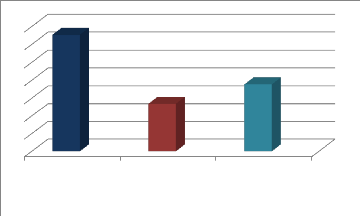
Asking
verification
questions
65.38%
Indicating
agreement /
disagreement
26.92%
Negotiating meaning
37.69%
33
Diagram5. Students' Techniques for Checking their
Understanding
34
Chapter III Presentation of the Findings
In this Table 5 and Diagram 5, we notice that half of our
population (65.38%) asks their teachers to check whether they understood well
the information; (26.92%) of them do indicate agreement or disagreement and
(37.69%) of them choose to negotiate meaning.
Q5: Do you think that negotiation during collaborative
activities is important for developing your communication skills?
|
Options
|
Participants
|
Percentages
|
|
Yes
|
130
|
100%
|
|
No
|
0
|
0%
|
|
Total
|
130
|
100%
|
Table6. The Significance of Negotiation during
Collaborative Activities
As presented in this table, all the participants believe that
negotiation during collaborative activities is important to enhance students'
communication skills and no one disagrees with that.
Justification
The students have explained that negotiation gives the
learners the chance to talk. According to them, it is by communicating that
students can express their opinions and share their ideas with the others.
Through negotiation, they believe they are able to express their ideas among
group members freely. One of the students has said: «It allows
[making] efforts to speak and express one's opinions with the target
language. Mistakes might be corrected by the teacher or classmates. Indeed, we
learn better from our mistakes and this is helpful to get rid of
shyness». Other learners answer: «It helps the students to
get involved in the communication process which helps them to develop their
speaking skill as well as their cognitive abilities and critical
thinking».
35
Chapter III Presentation of the Findings
According to some others, negotiation allows students to
debate about new themes by putting background knowledge into practice;
furthermore, it «helps the students to improve their learning
capacities in oral [speaking]». Finally, a student has said:
«when you negotiate, you push yourself to use an appropriate
vocabulary related to a given topic and it makes you develop your
[critical] thinking and become more fluent [in
speaking]».
Q6: Do you learn better when collaborating or when
learning individually? Why?
|
Item
|
Participants
|
Percentages
|
|
Collaboratively
|
113
|
87%
|
|
Individually
|
17
|
13%
|
|
Total
|
130
|
100%
|
Table7. Students' Preferences in Learning
In this table, it is shown that the majority of Master One
students (87%) do prefer to learn collaboratively; whereas, (13%) of them do
prefer to learn individually.
Justification
|
Items
|
Participants
|
Percentages %
|
a. Collaborative learning enhances involvement in the
classroom
|
72
|
55.38%
|
b. Collaborative learning improves confidence through
interaction
|
64
|
49.23%
|
c. I feel uncomfortable and distracted when practicing a
collaborative activity
|
24
|
18.46%
|
d. I do not have the opportunity to voice my ideas and opinions
freely within a group
|
|
14
|
10.77%
|
|
Table8. Students' Reasons of their Learning
Preferences
36
Chapter III Presentation of the Findings
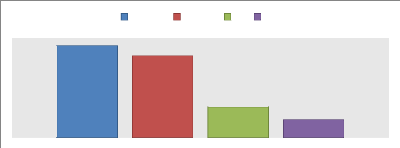
55.38%
a. b. c. d.
49.23%
18.46%
10.77%
Diagram6. Students' Reasons of their Learning
Preferences
According to the data displayed in table 8 and Diagram 6,
among the students who prefer to learn collaboratively, (55.38%) which
represent 72 students argue that collaborative learning enhances involvement in
the classroom; whereas, 64 students which is the equivalent of (49.23%),
believe that collaborative learning improves confidence through interaction.
Conversely, among the students who prefer to learn individually, 24 students or
(18.46%) justify their choice by feeling uncomfortable and distracted when
practicing a collaborative activity; while (10.77%) or 14 students pretend not
having the opportunity to voice their ideas and opinions freely within a
group.
3.1.3. Students' Attitudes towards Developing
Communication Skills through Collaborative Visualisation
Q1: How can collaborative visualisation help the
students develop their communication skills?
|
Suggestions
|
Responses
|
Percentage of the
Responses%
|
a. It promotes the exchange of information
|
70
|
53.85%
|
b. It encourages you to participate more
|
|
64
|
49.23%
|
|
37
Chapter III Presentation of the Findings
c. It allows you to learn more
|
53
|
40.77%
|
d. It develops your critical thinking
|
37
|
28.46%
|
e. It facilitates the understanding of
presented
information
|
34
|
26.15%
|
f. It supports the remembering of the
presented contents
|
|
24
|
18.46%
|
|
Table9. Collaborative Visualisation and Promoting
Communication Skills
a. b. c. d. e. f.
53.85%
49.23%
40.77%
28.46% 26.15%
18.46%
Diagram7. Collaborative Visualisation and Promoting
Communication Skills
Table 9 and Diagram 7 demonstrate how collaborative
visualisation helps the students to develop their communication skills. On the
one hand, the majority of Master One students (53.85%) believe that
collaborative visualisation promotes the exchange of information; (49.23%)
think that it encourages the students to participate more; whereas, (40.77%)
foresee that it allows them to learn more. On the other hand, (28.46%) say that
it develops their critical thinking; (26.15%) state that it facilitates the
understanding of presented information, and for the remaining (18.46%),
collaborative visualisation supports the remembering of the presented
contents.
38
Chapter III Presentation of the Findings
Q2: « The combination of Collaborative Learning and
Visualisation gives better results in learning in general and in developing
communication skills in particular»
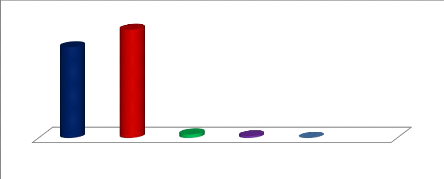
Strongly agree
Agree Slightly
agree
Disagree Strongly
disagree
?
47.69%
40%
1.54% 0.77% 0%
Diagram8. Students' Attitudes toward Promoting
Communication Skills through Combining Visualisation with Collaborative
Learning
As this graph indicates, (47.69%) agree with the fact that
combining collaborative learning with visualisation gives better results in
learning and in promoting communication skills; (40%) of them strongly agree
and only (1.54%) of the respondents slightly agree with this fact. No one
strongly disagrees and (0.77%) of them disagree with that.
Justification
|
Items
|
Participants
|
Percentages %
|
a. It is not sufficient to communicate effectively and
clearly
|
8
|
6.15%
|
b. It is time consuming
|
8
|
6.15%
|
c. It is difficult and requires a lot of efforts
|
3
|
2.31%
|
d. It makes communication flexible
|
45
|
34.62%
|
e. It is enjoyable
|
57
|
43.85%
|
f. It increases credibility of the communicated message or
information
|
|
37
|
28.46%
|
|
Table10. Promoting communication skills through
Collaborative Learning with
Visualisation
39
Chapter III Presentation of the Findings
a. b. c, d. e. f.
43.85%
|
|
|
34.62%
|
|
|
|
|
|
|
28.46%
|
|
|
|
|
|
|
|
|
|
|
|
|
|
|
|
|
6.15% 6.15% 2.31%
|
|
|
|
|
|
|
|
|
|
|
|
|
|
|
|
|
|
|
|
Diagram9. Promoting communication skills through
Collaborative Learning with
Visualisation
According to table 10 and Diagram 9, the majority of the
students have a positive opinion about the combination of visualisation and
collaborative learning. Most of them, 57 students or (43.85%) agree that
learning becomes enjoyable when the two are combined; (34.62%) argue that it
makes communication flexible. A few of Master One students (28.46%) believe
that it increases credibility of the communicated message or information.
Contrary to the majority, the minority of the students have a negative point of
view about the combination. An equal number of students which is 8 or (6.15%)
believe that it is time consuming; therefore, it is not sufficient to
communicate effectively and clearly. The remaining, which represents (2.31%),
thinks that it is difficult and requires a lot of efforts.
Q3: Do you agree that making use of collaborative
visualisation may lead to debates?
|
Items
|
Participants
|
Percentages %
|
|
Yes
|
125
|
96.15
|
|
No
|
5
|
3.85%
|
|
Total
|
130
|
100%
|
Table11. Debating through collaborative
visualisation
40
Chapter III Presentation of the Findings
It is displayed in this table that almost all the students
(96.15%) agree that collaborative visualisation may lead to debates and only
(3.85%) who disagree with that.
Q4: To what extent would the use of collaborative
visualisation improve your communication skills?
Very much Somewhat Do not know Not very much Not at
all

56.92%
37.69%
2.31% 3.08% 0%
Very much Somewhat Do not Not very Not at all
know much
Diagram10. Students' Attitudes toward Developing
Communication Skills through
Collaborative Visualisation
The results have revealed that the majority of students
(56.92%) approve that collaborative visualisation can improve their
communication skills very much; (37.69%) of them have claimed that it can
somewhat promote their communication skills while (3.08%) have said that
collaborative visualisation is effective in developing communication skills,
but not very much. (2.31%) of them do not know and no one thinks that
collaborative visualisation would not enhance their communication skills at
all.
Q5: How can collaborative visualisation, both
synchronous and asynchronous, help in developing communication
skills?
|
Items
|
participants
|
Percentages %
|
|
a. It enables students to see data,
communicate and debate in context
|
88
|
67.69%
|
41
Chapter III Presentation of the Findings
b. It provides immediate feedback
|
62
|
47.69%
|
c. Better real time response
|
22
|
16.92%
|
d. It motivates to rapidly think and answer
|
49
|
37.69%
|
e. It provides the ability to communicate with a remote team
with members of multiple zones
|
38
|
29.23%
|
f. Having a record of the communication
shared that can be
referred to later on
|
14
|
10.77%
|
g. The chance to think before responding
|
|
49
|
37.69%
|
|
Table12. Effectiveness of Synchronous and Asynchronous
Collaborating in
Promoting Students' Communication Skills
a. b. c. d. e. f. g.
67.69%
47.69%
29.23%
16.92%


10.77%
Diagram11. Effectiveness of Synchronous and Asynchronous
Collaborating in
Promoting Students' Communication Skills
Table 12 and Diagram 10 reveal how collaborative
visualisation, both synchronous and asynchronous, can help in developing
communication skills. It demonstrates that 88 out of 130 students think that
collaborative visualisation enables students to see data, communicate and
debate in context. Then, 62 of them say it provides immediate feedback. After
that, the answers have been split equally which means 49 students. On the one
hand, it motivates to rapidly think and answer; on the other hand, it gives the
chance to think before
42
Chapter III Presentation of the Findings
responding. 38 Master One students state that collaborative
visualisation provides the ability to communicate with a remote team with
members of multiple zones when it is asynchronous; however, 22 think that it
gives a better real time response. Finally, only 14 students believe that
asynchronous collaborative visualisation allows the students to have a record
of the communication shared that can be referred to later on.
3.2. Presentation of the Results of Teachers' Interview
3.2.1. General Questions
Question 1: How long have you been teaching
English?
This question is asked to determine the teachers' experience with
teaching English. The results show that the majority of respondents (05
teachers) have taught English for more than 10 years. However, there is only
one teacher who has less than 10 years of experience. Question2: Have
you ever been abroad for a training period?
This question is to know about teachers' experience abroad in
the English speaking context, the results show that most of them (04 teachers)
have been for a training period abroad while two of them have been in training
periods here in Algeria.
3.2.2. Teachers' Attitudes towards Collaborative
Learning
Question3: Do you agree that «Mutual activation
(active collaboration among students) and share of knowledge is foundational
for developing students' communication skills». Please, would you
explain?
This question aims at showing the extent to which teachers
agree with the fact that mutual activation is important for developing
communication skills and explaining the way and the reason why it is so. All of
the respondents agree with this and they have explained it in different ways.
Two of them have argued that students learn better from their mates and feel at
ease while working together. One of them has claimed that this mutual
activation
43
Chapter III Presentation of the Findings
should be in all classes; through it, students who know more
help students who know less. The fourth respondent thinks that it is important
but not foundational. He affirms that it is important to share knowledge and
develop it; and that oral expression, which is essential in communication, is
situational which means that students should have shared knowledge of
vocabulary of each situation to better communicate. The sixth teacher
determines that mutual activation and shared knowledge are basic element of
communication; it helps to foster dialogues and promotes interaction.
Question4: Do you think that «Grounding
(knowledge of the basics of something) or creating a common frame of reference
(particular set of beliefs or ideas on which you base your judgment of
things)» is important to promote students' communication
skills?
This question is intended to show what teachers think of
grounding. All the respondents share the idea that grounding is vital and that
it makes communication better and the majority of them (05 teachers) have
claimed that without grounding, students will not collaborate and communication
will be difficult. One of the teachers argues that a common frame of reference
helps students to answer questions, solve problems, learn new things and
understand better; and that its absence leads to a high risk of having some
learners at the back because they do not follow the course of the
discussion.
Question5: Do your students try to maintain the
discussion during a collaborative activity?
This question aims at discovering whether students maintain
the discussion in class and the ways they use to do it. All the interviewed
teachers have said that their students do try to maintain the discussion during
a collaborative activity and the majority of them have claimed that their
students ask questions to start a discussion while two of them have said that
their students use all the suggested techniques depending on the module and the
context,
44
Chapter III Presentation of the Findings
which means through asking questions, suggesting ideas, giving
one's opinion, clarifying and summarising what has been said and through
providing feedback.
Question6: Do you check your students' understanding
of what has been communicated in the classroom? How?
The purpose of this question is to know if teachers check
their students' understanding and the techniques they do follow for this. All
of them share the technique of asking verification questions and say that they,
sometimes, do refer to the two other suggested techniques namely; indicating
agreement / disagreement and negotiating meaning at the end. Question7:
Do you think that negotiation among students during collaborative activities is
important for developing their communication skills? If yes, how?
The results of this question indicate what teachers do think
of negotiation in terms of developing communication skills. All of them agree
that negotiation is important. They have all argued that it permits to students
to express themselves and to put their knowledge into practice; they have added
that when there is no negotiation, there is no collaboration and there is no
communication.
3.2.3. Teachers' Attitudes towards Developing
Communication Skills through Collaborative Visualisation.
Question8: Do you think that collaborative
visualisation should replace the traditional way of teaching?
The aim of this question is to know whether it is possible for
collaborative visualisation to replace the traditional way of teaching. All the
respondents share the idea that collaborative visualisation, rather than
replacing the traditional way of teaching, should complement it.
Question9: Do you agree that collaborative visualisation
is:
a. A good strategy of teaching.
45
Chapter III Presentation of the Findings
b. It needs to be encouraged.
c. It makes the lesson more enjoyable.
d. It should be used in all modules.
This question aims at knowing what teachers think of
collaborative visualisation. The majority of the respondents (05 teachers) have
shared the first two choices, which means that collaborative visualisation is a
good strategy of teaching and it should be encouraged while one of them is for
all the four suggestions.
Question10: Do you think that using collaborative
visualisation would improve students' communication skills?
The purpose of this question is to find out what teachers
think of collaborative visualisation as a technique to promote students'
communication skills. Four teachers out of six have said that it is an
important technique that can help students to better communicate. Two of them
have added that it depends on the topic and the situation and that, it is not
sufficient alone, it should be reinforced and well planned in advance in order
to get fruitful results.
Question11: Do you agree that making use of
collaborative visualisation may lead to debates?
This question permits to know whether teachers think that
collaborative visualisation may lead to debates and all of them agree that it
does, because students when they see something together they are most of the
time motivated to comment it and ask questions about it.
46
Chapter III Presentation of the Findings
Question12: What are the difficulties that you may
encounter with the implementation of collaborative visualisation?
This question is meant to determine the difficulties that
teachers may face if they implement collaborative visualisation. All the
teachers who have been interviewed have agreed on the lack of materials.
| 


